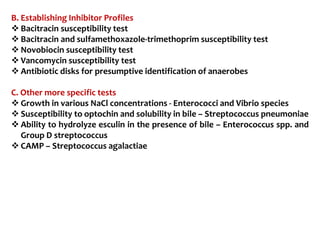Describe the Process of Bacterial Identification Using Biochemical Tests
Developments in biochemical methodologies and strategies for microbial isolation and identification in the environment general concerns about and health benefits of natural products food preservation and safety as well as genetically modified crops in agriculture. Few of them are required to be carried out depending upon the bacteria.
To identify the bacterial unknowns in a mixed culture by morphological and biochemical methods.
. This is based on the following chain of logic. The instructions for completing the LabPaq experiment are located at the. Differentiation of the species is further characterized by enzyme tests including catalase characteristically positive for all Staphylococcus species and coagulase specific for S.
When bacteria is grown in this medium there may be the production of acids or alkali or even no. Bacterial identification can also be based on the proteins produced under specific growth conditions within the human body. Detects the genetic code of bacteria DNA Not influenced by gene expression.
47 biochemical tests and one negative control well. In a recent multi-site study the performance of the VITEK 2 GN was evaluated using 562 isolates of both commonly and rarely observed species of. Bacteria is grown in the peptone water culture.
Identification of bacteria by biochemical tests. After 48 to 96hrs incubation at 37C it. These biochemical tests include the test for carbohydrates and triple sugar a test that indicates the presence of starch which then.
The list of test substrates is shown in Table 7. Biochemical tests are the tests used for the identification of bacteria species based on the differences in the biochemical activities of different bacteria. Biochemical tests are applied to the appropriate specimen and include gram staining followed by culturing the bacterial isolate in mannitol salt agar.
Each different species of bacterium has a different molecule of DNA ie DNA with a unique series of nucleotide bases. - Biochemical testing is a type of culture test that can be performed on microbial isolates obtained from the patient. The identification of bacteria is a careful and systematic process that uses many different techniques to narrow down the types of bacteria that are present in an unknown bacterial culture.
Biochemical Testing for Microbial Identification. And a pH indicator and 2 the breath test in which a patient drinks urea labeled with an. This is based on the following chain of logic.
I hope this book will be a compendium of ideas which many people will use in the. To identify bacteria we must rely heavily on biochemical testing. Use needle to inoculate pure bacterial culture into the two test tubes with semi-solid medium.
The commonly used biochemical tests are as mentioned below a Catalase test. Cheap Experience with use Does not require. Next complete the microbial identification experiments listed below.
Then write a lab report discussing the results of these experiments. For this task complete the Aseptic Technique and Culturing Microbes LabPaq experiment. The staining is followed by use of various biochemical reagents and tests to get closer to the identification of bacteria.
OXIDATIONFERMENTATION OF test aerobic oxidative catabolism GLC CO 2 H 2 O anaerobic catabolism fermentation GLC organic molecule gas - in both aerobic and anaerobic conditions - some bacteria dont utilise GLC PROCEDURE. The types of biochemical reactions each organism undergoes act as a thumbprint for its identification. This test is used to identify bacteria that can hydrolyze starch amylose and amylopectin using the enzymes a-amylase and oligo-16-glucosidase.
Final identification results are available in approximately 10 hours or less. Biochemical tests are used for microbial identification based on difference lye in their biochemical activities exhibited by di fferent types of. Detects the physical properties of bacteria Influenced by gene expression Includes biochemical tests.
Because of the large size of amylose and amylopectin molecules these organisms can not pass through the bacterial cell. Often used to differentiate species from the genera Clostridium and Bacillus. The types of biochemical reactions each organism undergoes act as a thumbprint for its identification.
Phenotypic test Genotypic test. Several steps and multiple staining methods are required to differentiate cell types and cell structures using differential staining methods. There are many biochemical tests available for bacterial identification.
- Phage testing is a type of testing method that can be performed on the patient to aid in the process of microbial identification. To perform proteomic analysis proteins from the pathogen are first separated by high-pressure liquid chromatography HPLC and the collected fractions are then digested to yield. Identification of Bacteria using Staining Techniques A differential staining technique is more frequently used in microbiology to gather information about bacteria than simple stains.
These types of identification procedures are called proteomic analysis. To identify bacteria we must rely heavily on biochemical testing. Bacterial physiology differs from one species to the other.
Each different species of bacterium has a different molecule of DNA ie DNA with a unique series of nucleotide bases. Describe two methods to test for the enzyme urease. Eg coagulase for staphylococcal ID.
1 A biochemical test conducted in the laboratory using a medium that contains urea. The different ways to categorize bacterial species include the morphology or shape which can be determined by staining the 16s DNA fatty acid analysis can be done on the bacteria and there are also different tests that can be done using biochemistry.

Biochemical Tests For Identification Of Bacteria

Bacterial Biochemical Identification Kits Creative Diagnostics

Biochemical Tests For The Identification Of Bacteria Types Principle Procedure And Examples The Science Notes
Belum ada Komentar untuk "Describe the Process of Bacterial Identification Using Biochemical Tests"
Posting Komentar